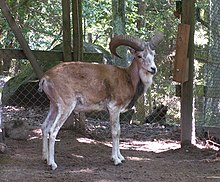
The mouflon is a wild sheep native to Caspian region, including eastern Turkey, Armenia, Azerbaijan, Georgia and Iran. It is also found in Europe. It is thought to be the ancestor of all modern domestic sheep breeds.

Ablepharus is a genus of skinks that contains the common snake-eyed skinks. Both their scientific and common names refer to the fact that their eyelids have fused to a translucent capsule; as in snakes, they thus are physically incapable of blinking. They are small lizards and prefer to live in the leaf litter of dry fields and hills. Their scales give them a very shiny, bronze appearance with a characteristically dark stripe down the sides of their bodies. They prey on small insects and other small mollusks.

The goitered gazelle or black-tailed gazelle is a gazelle native to Turkey, Georgia, Azerbaijan, Iran, parts of Iraq and Pakistan, Afghanistan, Tajikistan, Kyrgyzstan, Uzbekistan, Turkmenistan, Kazakhstan and in northwestern China and Mongolia. The specific name, meaning "full below the throat", refers to the male having an enlargement of the neck and throat during the mating season.
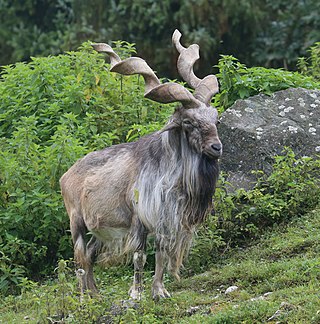
The markhor is a large wild Capra (goat) species native to South Asia and Central Asia, mainly within Pakistan, India, the Karakoram range, parts of Afghanistan, and the Himalayas. It is listed on the IUCN Red List as Near Threatened since 2015.

The wild goat is a wild goat species, inhabiting forests, shrublands and rocky areas ranging from Turkey and the Caucasus in the west to Turkmenistan, Afghanistan and Pakistan in the east. It has been listed as near threatened on the IUCN Red List and is threatened by destruction and degradation of habitat.
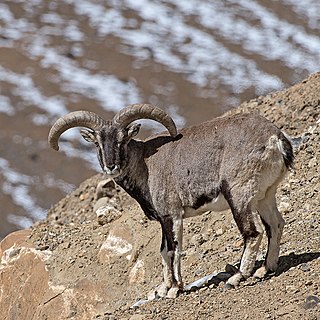
The bharal, also called the blue sheep, is a caprine native to the high Himalayas. It is the only member of the genus Pseudois. It occurs in India, Bhutan, China, Myanmar, Nepal, and Pakistan. The Helan Mountains of Ningxia have the highest concentration of bharal in the world, with 15 bharals per km2 and 30,000 in total.

The argali, also known as the mountain sheep, is a wild sheep that roams the highlands of western East Asia, the Himalayas, Tibet, and the Altai Mountains.
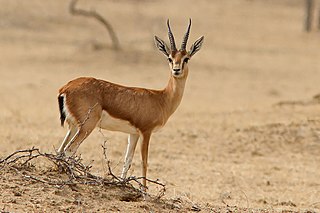
The chinkara, also known as the Indian gazelle, is a gazelle species native to India, Iran, Afghanistan and Pakistan.

UTC+05:00 is an identifier for a time offset from UTC of +05:00. This time is used in:

The Marco Polo sheep is a subspecies of argali sheep, named after Marco Polo. Their habitat are the mountainous regions of Central Asia. Marco Polo sheep are distinguishable mostly by their large size and spiraling horns. Their conservation status is "near threatened" and efforts have been made to protect their numbers and keep them from being hunted. It has also been suggested that crossing them with domestic sheep could have agricultural benefits.
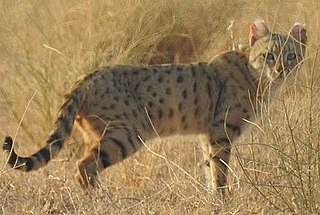
The Asiatic wildcat, also known as the Asian steppe wildcat and the Indian desert cat, is an African wildcat subspecies that occurs from the eastern Caspian Sea north to Kazakhstan, into western India, western China and southern Mongolia. There is no information on current status or population numbers across the Asiatic wildcat's range as a whole, but populations are thought to be declining.

Hyles hippophaes, the seathorn hawk-moth, is a species of moth in the family Sphingidae. The species was first described by Eugenius Johann Christoph Esper in 1789.

The wildlife of Pakistan comprises a diverse flora and fauna in a wide range of habitats from sea level to high elevation areas in the mountains, including 195 mammal, 668 bird species and more than 5000 species of Invertebrates. This diverse composition of the country's fauna is associated with its location in the transitional zone between two major zoogeographical regions, the Palearctic, and the Oriental. The northern regions of Pakistan, which include Khyber Pakhtunkhwa and Gilgit Baltistan include portions of two biodiversity hotspot, Mountains of Central Asia and Himalayas.

Godfrey Thomas Vigne was an English amateur cricketer and traveller.
The Ustyurt mountain sheep, often referred to as the Turkmenian mountain sheep, is a subspecies of the urial that inhabits the mountain plateau regions of parts of Central Asia, especially the Ustyurt plateau from which it takes its name. It is particularly common in northern and eastern Turkmenistan and western Kazakhstan.

Galeodes is a genus of solifuges or sun spiders. The nearly 200 species in this genus are found in northern Africa, southeastern Europe and Asia. Like other solifuges, they are mainly nocturnal and found in arid habitats. They often have long hairy appendages and are not as stout bodied or dark and contrastingly coloured as some other solifuges. Some Galeodes species are able to produce sounds by stridulation. These are usually raspy or hiss-like and may be imitations of the sounds of vipers, to serve a defensive function. As in other solifuges, mating involves the male depositing a spermatogonia that is manipulated into the female genital opening using their chelicera. The male strokes the female using the palps allowing her to be approached. Females will often feed on males before or after mating. The female then deposits the eggs in a burrow in soil and in some species guards them.
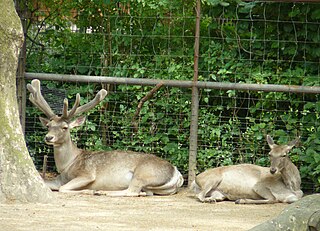
The wildlife of Turkmenistan is the flora and fauna of Turkmenistan, and the natural habitats in which they live. Turkmenistan is a country in Central Asia to the east of the Caspian Sea. Two thirds of the country is hot dry plains and desert, and the rest is more mountainous. Very little rain falls in summer and the chief precipitation occurs in the southern part of the country in the winter and spring. The Caspian coast has milder winters.

The Turkestan lynx is a subspecies of Eurasian lynx native to Central Asia. It is also known as Central Asian lynx, Tibetan lynx or Himalayan lynx. It is widespread from Central Asia, continental South Asia to China and Mongolia. About 27,000 mature individuals have been estimated to occur in China as of 2013.

The Ziarat Juniper Forest is a juniper forest in Ziarat, Balochistan, Pakistan.

Juniperus seravschanica is a species of juniper. Common names include Pashtun juniper.
